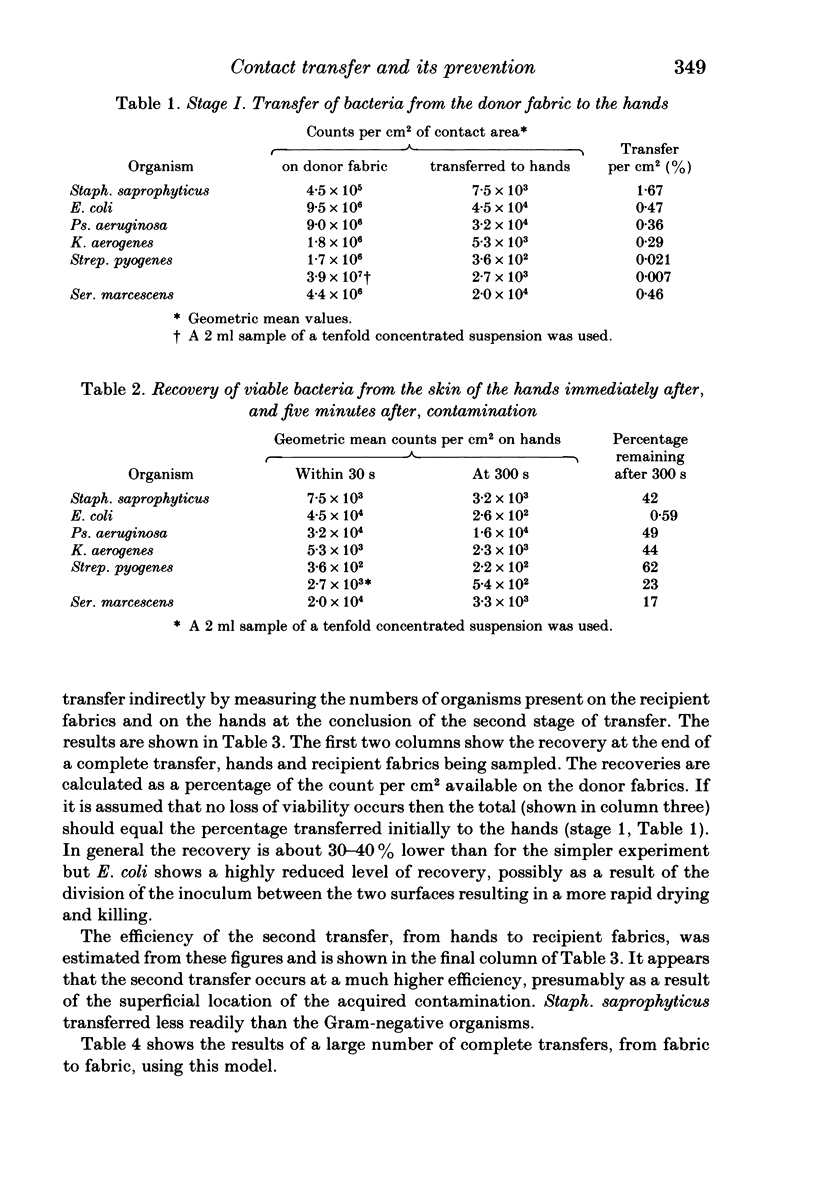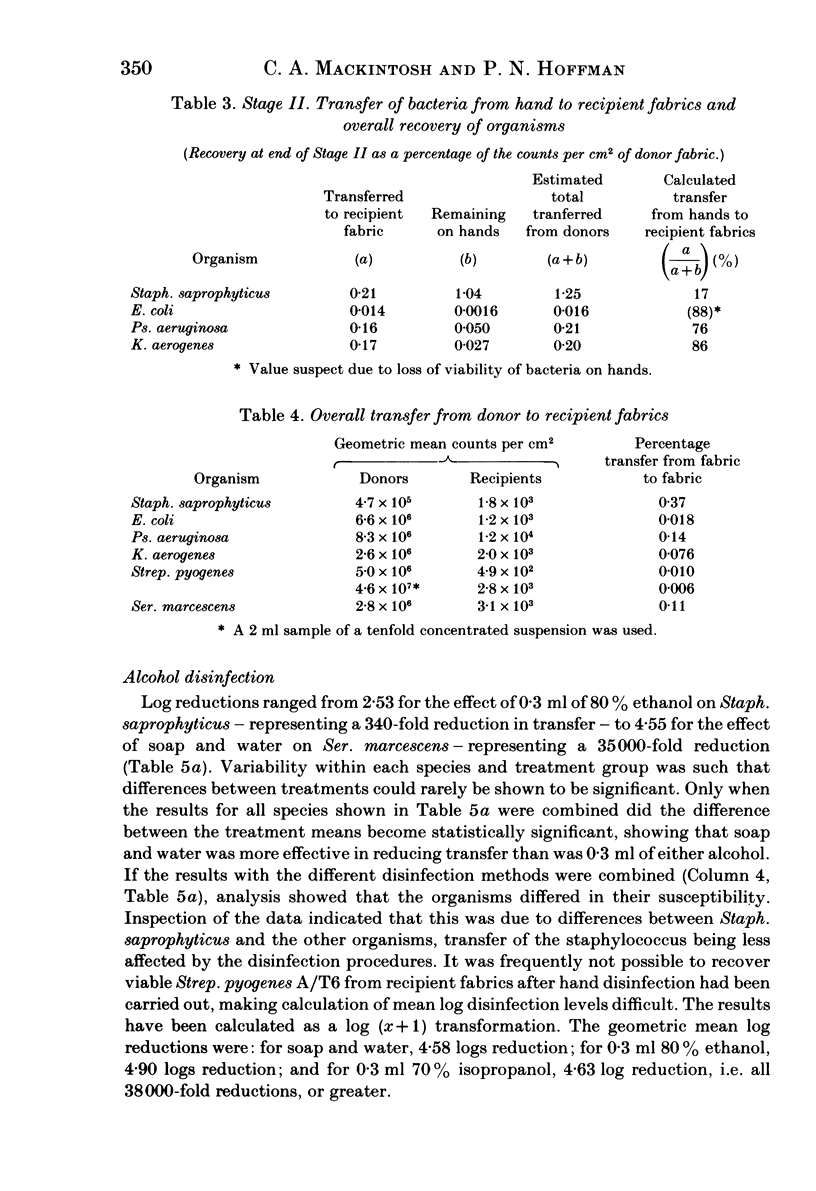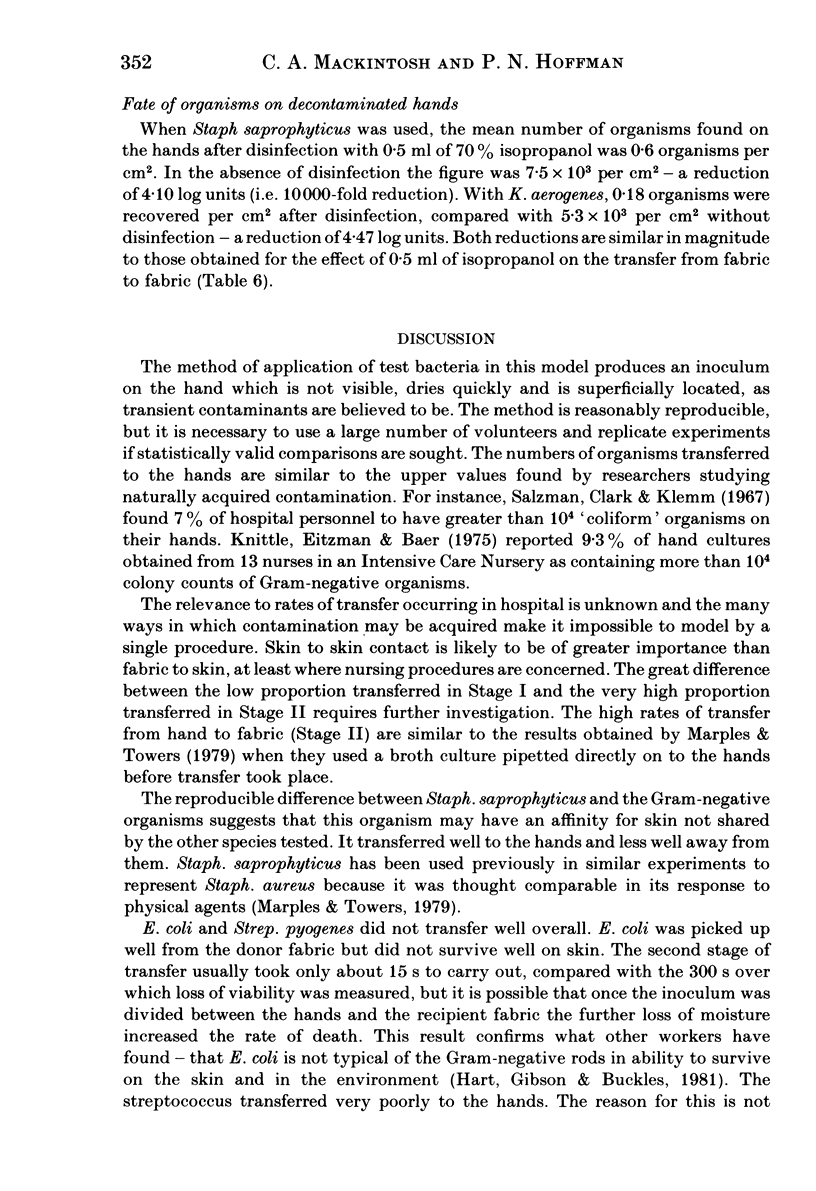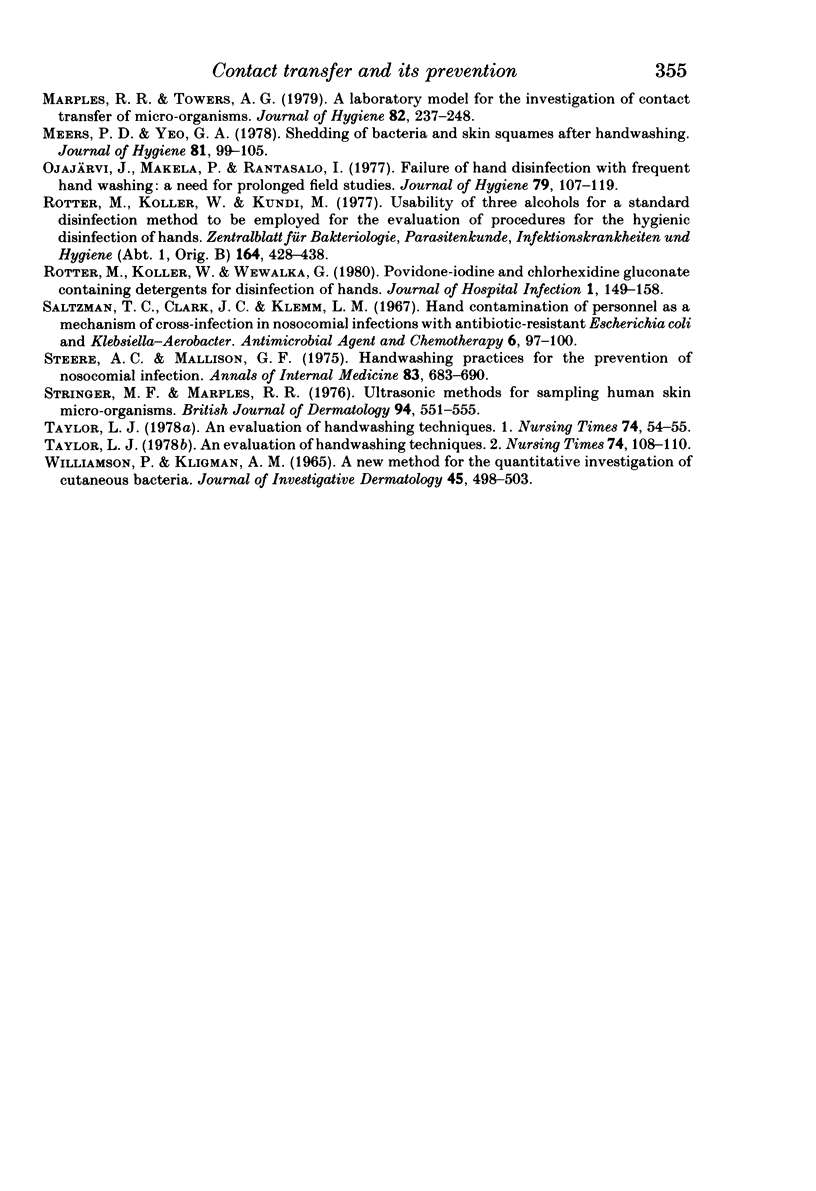Abstract
A model for contact transfer of micro-organisms by hand has been extended to include representatives of bacterial species responsible for a majority of hospital-acquired infections. The ability of the organisms to transfer from contaminated fabrics to hands and from hands to sterile fabrics was measured, as was their ability to survive on the skin of the hands. There were differences between the species. Staphylococcus saprophyticus transferred well to the hand but not as well from hand to fabric as the other species; it survived well on skin. Pseudomonas aeruginosa, Klebsiella aerogenes and Serratia marcescens transferred moderately well overall and also survived on the skin. These results were in contrast to those obtained with a strain of Escherichia coli and one of Streptococcus pyogenes. The contact transfer model was used to investigate the use of small volumes of alcohol in preventing transfer via the hands. An alcohol handrub of either 0.3 ml 80% ethanol or 0.3 ml 70% isopropanol gave reductions in transfer slightly less than that of a soap and water wash. Raising the volume, and consequently the contact time, to 0.5 ml 70% isopropanol gave a 14000-fold reduction in transfer, statistically indistinguishable from that of a thorough soap and water wash (9800-fold reduction).
Full text
PDF










Selected References
These references are in PubMed. This may not be the complete list of references from this article.
- Albert R. K., Condie F. Hand-washing patterns in medical intensive-care units. N Engl J Med. 1981 Jun 11;304(24):1465–1466. doi: 10.1056/NEJM198106113042404. [DOI] [PubMed] [Google Scholar]
- Aly R., Maibach H. I. A comparison of the antimicrobial effect of 0.5% chlorhexidine (Hibistat) and 70% isopropyl alcohol on hands contaminated with Serratia marcescens. Clin Exp Dermatol. 1980 Jun;5(2):197–201. doi: 10.1111/j.1365-2230.1980.tb01688.x. [DOI] [PubMed] [Google Scholar]
- Ayliffe G. A., Babb J. R., Quoraishi A. H. A test for 'hygienic' hand disinfection. J Clin Pathol. 1978 Oct;31(10):923–928. doi: 10.1136/jcp.31.10.923. [DOI] [PMC free article] [PubMed] [Google Scholar]
- Dineen P. Hand-washing degerming: a comparison of povidone-iodine and chlorhexidine. Clin Pharmacol Ther. 1978 Jan;23(1):63–67. doi: 10.1002/cpt197823163. [DOI] [PubMed] [Google Scholar]
- Hart C. A., Gibson M. F., Buckles A. M. Variation in skin and environmental survival of hospital gentamicin-resistant enterobacteria. J Hyg (Lond) 1981 Oct;87(2):277–285. doi: 10.1017/s0022172400069497. [DOI] [PMC free article] [PubMed] [Google Scholar]
- Knittle M. A., Eitzman D. V., Baer H. Role of hand contamination of personnel in the epidemiology of gram-negative nosocomial infections. J Pediatr. 1975 Mar;86(3):433–437. doi: 10.1016/s0022-3476(75)80980-2. [DOI] [PubMed] [Google Scholar]
- Marples R. R., Towers A. G. A laboratory model for the investigation of contact transfer of micro-organisms. J Hyg (Lond) 1979 Apr;82(2):237–248. doi: 10.1017/s0022172400025651. [DOI] [PMC free article] [PubMed] [Google Scholar]
- Meers P. D., Yeo G. A. Shedding of bacteria and skin squames after handwashing. J Hyg (Lond) 1978 Aug;81(1):99–105. doi: 10.1017/s0022172400053808. [DOI] [PMC free article] [PubMed] [Google Scholar]
- Ojajärvi J., Mäkelä P., Rantasalo I. Failure of hand disinfection with frequent hand washing: a need for prolonged field studies. J Hyg (Lond) 1977 Aug;79(1):107–119. doi: 10.1017/s0022172400052906. [DOI] [PMC free article] [PubMed] [Google Scholar]
- Rotter M., Koller W., Wewalka G. Povidone-iodine and chlorhexidine gluconate-containing detergents for disinfection of hands. J Hosp Infect. 1980 Jun;1(2):149–158. doi: 10.1016/0195-6701(80)90047-x. [DOI] [PubMed] [Google Scholar]
- Salzman T. C., Clark J. J., Klemm L. Hand contamination of personnel as a mechanism of cross-infection in nosocomial infections with antibiotic-resistant Escherichia coli and Klebsiella-Aerobacter. Antimicrob Agents Chemother (Bethesda) 1967;7:97–100. [PubMed] [Google Scholar]
- Steere A. C., Mallison G. F. Handwashing practices for the prevention of nosocomial infections. Ann Intern Med. 1975 Nov;83(5):683–690. doi: 10.7326/0003-4819-83-5-683. [DOI] [PubMed] [Google Scholar]
- Stringer M. F., Marples R. R. Ultrasonic methods for sampling human skin micro-organisms. Br J Dermatol. 1976 May;94(5):551–555. doi: 10.1111/j.1365-2133.1976.tb05145.x. [DOI] [PubMed] [Google Scholar]
- Taylor L. J. An evaluation of handwashing techniques-1. Nurs Times. 1978 Jan 12;74(2):54–55. [PubMed] [Google Scholar]
- Taylor L. J. An evaluation of handwashing techniques-2. Nurs Times. 1978 Jan 19;74(3):108–110. [PubMed] [Google Scholar]
- Williamson P., Kligman A. M. A new method for the quantitative investigation of cutaneous bacteria. J Invest Dermatol. 1965 Dec;45(6):498–503. doi: 10.1038/jid.1965.164. [DOI] [PubMed] [Google Scholar]


